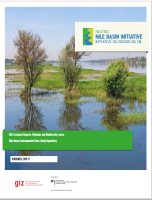Abstract
The continuous collection of both hydrological and Meteorological data has been a problem in most
areas of the world. Therefore, such data normally have gaps in the time series. For proper water
quality management of any river or lake basin there must be a basis for quantification of pollution
loads transported in the water. This is only possible if discharge data is known for the duration
of study. In order to fill gaps existing in such data, a modelling approach can be employed to
generate the missing data. An appropriate model must therefore be used in such cases. The changes
in discharge depend on precipitation but can also be heavily influenced by various activities in
the catchment.
Estimation of flow for rivers Sio, Nzoia and Yala draining the northern catchment of the Kenyan
basin of Lake Victoria was carried out for a 50-year period. This study used the NAM hydrological
model in order to fill in the missing data for a time series and estimate the flow. In order to
generate initial continuous rainfall data for a minimum of 5 years, employing a double mass curve
technique using the data measured at different stations did a correlation. Lake level (stage) was
used to estimate rainfall for the gaps after the correlation. Continuous data for 50 years from
1950 to 2000 was finally generated and used for the calculation of discharge for the three rivers.
The variation in discharge for the 50 years period was therefore evaluated.
The average discharge results showed that Nzoia had a discharge of 118 m3/s; Sio 12.1 m3/s and
Yala had
27.4 m3/s. There was a general increase in flow over the years contributing to the water balance of
the lake and also pointing to increase in rainfall run-off possibly resulting from degradation of
the catchment.



